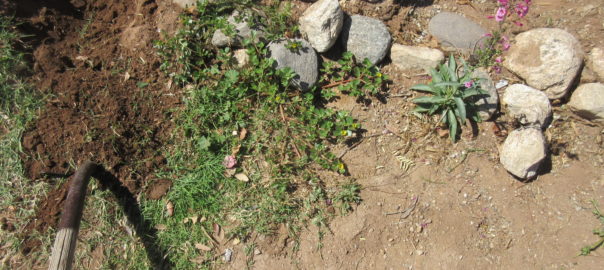
“I need to keep digging to find that leak,” I updated my school gardening colleague. “There’s a leak?” he asked, surprised. I remembered he’d been off campus for a week and had seen neither my new dirt pile or the trail of bermudagrass, purslane, and mallow that had suddenly appeared on a soil slope with no known irrigation emitter. It was the trail of weeds that led me to discover water seeping up from underground. A cheerful pink penstemon and a fledgling Texas Ranger had appeared about the same time, so I wasn’t in too big of a rush to remedy the situation. Still, I needed to get two crisscrossing irrigation systems in order before Summer Break. Thank you, bermudagrass, for showing me where to dig.
Bermudagrass has been to me over the years: a front yard lawn to play in, a school field to lunch on, a school garden nemesis to take on, an excuse for exercise, a form of meditation, a topic to educate about, and a red flag for water out of place. Bermudagrass is an amazingly drought resistant, rapidly spreading, commonly planted turf grass in the Desert Southwest. Where it’s wanted, great. Where it’s not wanted, it’s a weed. In fact, bermudagrass is the weed that taught me to love pulling weeds.
Rewind to fall of 2000. I returned to the U of A after interning for 12 weeks in remote Badlands National Park. A senior Honors Thesis project, as yet undecided, loomed ahead. A yearning for the freedom and undeveloped openness of my summer home tugged at me also. Plus I had tests to tackle and romantic drama to reckon with. So, I started a school garden. It wasn’t quite that simple, but it was exactly what I found out I wanted to do.
Among the necessary tasks? The bermudagrass in the corner of the school playground would have to go. Each Wednesday, I fidgeted like a little kid through my Anthropology class until I could help elementary students learn about desert plants and animals and plan our garden. To prepare the way, I went on weekends to dig up the incredibly tough, sneaky, regrowing grass. This became my physical exercise: stabbing a shovel in and grabbing chopped out grass with my hands. It became my time alone in nature, in the middle of a bustling city. It became a way to both think and forget, to cleanse my brain with something like meditation were it not for the accompanying glee at destroying something.
Back in my current school garden, I finally found the responsible uncapped emitter. I had to dig deep, and imagine the removed tree that water used to sustain. I had to take a good look around, finding that bermudagrass on a spectrum – from tan to yellow to pale spring green to deep summer green – persisted all along the ridge where I stood. Add some extra water, and green bursts from tan. Now, the cap is in place, but still I dig. Thank you, bermudagrass, for keeping me alert, for keeping me fit, and for being a living thread from past to present.

